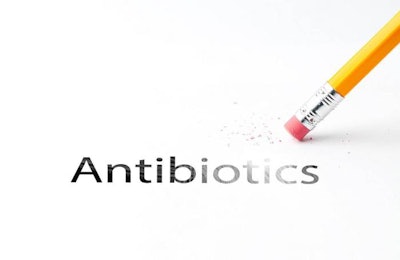
2 reports published in the United Kingdom in the past week show that the use of antibiotics in food-producing animals continues to fall.
For 2020, sales of veterinary antibiotics for use in food-producing animals in the U.K. amounted to 30.1 mg per kg. This is the headline finding of the U.K. Veterinary Antibiotic Resistance and Sales Surveillance Report (UK-VARSS 2020) published last week by the government’s Veterinary Medicines Directorate (VMD).
While the decline reported for 2020 was marginal compared with the 2019 level, it represents a decrease of 52% compared with 2014.
For the sixth successive year, sales of the highest priority critically important antibiotics for livestock were down. Now accounting to just 0.5% of all antibiotic sales, this category’s sales amounted to 0.14 mg/kg last year. This is a 79% reduction since 2014. Product group include fluoroquinolones, third- and fourth-generation cephalosporins, and colistin. In food-producing animals, use of colistin was halted in 2017.
The decline in antibiotic use applies to all food-producing animal species in the U.K. This is according to data provided to the VMD by the respective industry.
Overall, long-term changes amount to reductions of 28-88%, depending on the species. For the critically important antibiotics, the amounts used are down by between 35% (in trout) and 99% in meat poultry.
Also covered by the UK-VARSS 2020 report are the results of monitoring of antimicrobial resistance in poultry for selected zoonotic bacteria and clinical surveillance of AMR.
Progress report on updated antibiotic use targets
Offering an overview of the first year’s progress against an updated set of antibiotic use targets is the Targets Task Force 2 (TTF2) report. Also released last week, it was from the Responsible Use of Medicines in Agriculture Alliance (RUMA). The latest antibiotic use targets cover the period 2021-24, and the focus is on holistic aims rather than numerical targets.
Overall, RUMA concludes that U.K. livestock sectors are generally making good progress on antibiotic use targets. The Alliance acknowledges that the past year was one of unprecedented challenges, including the coronavirus (COVID-19) pandemic, and the U.K.’s exit from the European Union (Brexit). These have had wide-ranging adverse impacts on supply chains, infrastructure and labor.
“Despite an exceptional 12 months, there have been some great achievements realized in year one of the second set of RUMA Targets Task Force targets, which is testament to the hard work and commitment across all sectors,” said Cat McLaughlin, RUMA chair and chair of the RUMA Targets Task Force 2.
The aim of the latest targets is not a drive towards zero antibiotic use, she said.
“Antibiotics are needed when necessary as a tool to treat sick animals and to improve and maintain animal welfare,” said McLaughlin. “Each sector will ultimately reach a sustainable level below which further reductions could negatively impact animal welfare.”
Reaction to the reports’ findings
“At a time when we really need some good news, these come as a timely reminder of the effort and commitment put in by the industry to reduce antibiotic use in a responsible manner without compromising the health and welfare of our pigs,” said chief executive of the National Pig Association Dr. Zoe Davies. “It has been a team effort all along, with producers, vets and others working together.”
“This year’s VARSS report shows how the U.K. continues to make important reductions in antibiotic use in livestock across the board,” said the U.K.’s Chief Veterinary Officer, Christine Middlemiss. “It is encouraging to see farmers and vets continuing to work together to tackle antibiotic resistance through the responsible use of antibiotics, which in turn protects human health as well as reducing the burden of disease in animals.”
“Both the VARSS and RUMA reports provide important annual insights into how we’re doing in stewarding antibiotics use on farms across the U.K. and also how those efforts are paying off in terms of reducing the levels of resistance to antibiotics,” said James Russell, senior vice president of the British Veterinary Association.
Global trends in antibiotic use in animal agriculture
A downward trend has also been observed in the global use of antibiotics in animal agriculture.
In July, the World Organisation for Animal Health (OIE) published its fifth annual report on antimicrobial agents intended for use in animals.
Contributing data to the report were a record total of 160 countries. With each report in the series, a greater understanding is emerging of the use of these products in animal agriculture.
Among the key findings was that, worldwide, antimicrobial use (in terms of mg per kg of animal biomass) fell by 34% between 2015 and 2017. This indicates a positive trend over time in the more prudent and responsible use of antimicrobials in the animal health sector, according to the OIE.
An OECD study published a few months previously highlighted that public awareness, good biosecurity and long-term funding are key to reducing antimicrobial resistance in animal production.
This year’s World Antibiotic Awareness Week takes place on November 18-24. Organized jointly by the Food and Agriculture Organization (FAO) of the United Nations, World Health Organization, and the OIE, the theme of this year’s event is “Spread awareness, stop resistance.”













